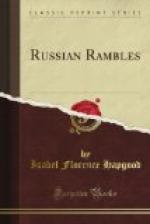How can I present a picture of all the variations in those sweet, busy-idle days? They vanished all too swiftly. But now the rick-yard was heaped high with golden sheaves; the carts came in steady lines, creaking under endless loads, from those fields which, two years later, lay scorched with drought, and over which famine brooded. The peasant girls tossed the grain, with forked boughs, to the threshing-machine, tended by other girls. The village boys had a fine frolic dragging the straw away in bundles laid artfully on the ends of two long poles fastened shaft-wise to the horse’s flanks. We had seen the harvesting, the plowing with the primitive wooden plow, the harrowing with equally simple contrivances, and the new grain was beginning to clothe the soil with a delicate veil of green. It was time for us to go. During our whole visit, not a moment had hung heavy on our hands, here in the depths of the country, where visitors were comparatively few and neighbors distant, such had been the unwearied attention and kindness of our hosts.
We set out for the river once more. This time we had a landau, and a cart for our luggage. As we halted to drink milk in the Tchuvash village, the inhabitants who chanced to be at home thronged about our carriage. We espied several women arrayed in their native costume, which has been almost entirely abandoned for the Russian dress, and is fast becoming a precious rarity. The men have already discarded their dress completely for the Russian. We sent one of the women home to fetch her Sunday gown, and purchased it on the spot. Such a wonderful piece of work! The woman had spun, woven, and sewed it; she had embroidered it in beautiful Turanian, not Russian, patterns, with silks,—dull red, pale green, relieved by touches of dark blue; she had striped it lengthwise with bands of red cotton and embroidery, and crosswise with fancy ribbons and gay calicoes; she had made a mosaic of the back which must have delighted her rear neighbors in church; and she had used the gown with such care that, although it had never been washed, it was not badly soiled. One piece for the body, two for the head, a sham pocket,—that was all. The footgear consisted of crash bands, bast slippers, rope cross-garters. The artists to whom I showed the costume, later on, pronounced it an ethnographical prize.
These Tchuvashi are a small, gray-eyed, olive-skinned race, with cheek-bones and other features like the Tatars, but less well preserved than with the latter, in spite of their always marrying among themselves. There must have been dilution of the race at some time, if the characteristics were as strongly marked as with the Tatars, in their original ancestors from Asia. Most of them are baptized into the Russian faith, and their villages have Russian churches. Nevertheless, along with their native tongue they are believed to retain many of their ancient pagan customs and superstitions, although baptism is in no




